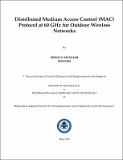| dc.contributor.advisor | Pillutla, Laxminarayana S. | |
| dc.contributor.author | Mudliar, Shweta | |
| dc.date.accessioned | 2017-06-10T14:44:02Z | |
| dc.date.available | 2017-06-10T14:44:02Z | |
| dc.date.issued | 2016 | |
| dc.identifier.citation | Mudliar, Shweta (2016). Distributed medium access control (MAC) protocol at 60 GHz for outdoor wireless networks. Dhirubhai Ambani Institute of Information and Communication Technology, viii, 39p. (Acc.No: T00556) | |
| dc.identifier.uri | http://drsr.daiict.ac.in/handle/123456789/593 | |
| dc.description.abstract | Growing demands of high bandwidth and data rates in wireless networks haveinspired the US Federal Commission Council (FCC) to free the licensed 60 GHzspectrum for emerging technologies. Typically, wireless networks operate at 2.4,3.6 or 5 GHz but these frequency bands have become more populous by virtue ofrising acceptance and demands across the globe. This craved a desire to incorporatewireless networks over 60 GHz. Potential challenges posed due to directionaldeafness, lack of signal penetration and higher attenuation due to oxygen absorptionhave to be overcome to realize the full potential of communications in this frequencyrange. In this thesis we focus on the design of efficient medium access control(MAC) protocols that overcome the aforementioned challenges posed by thetransmission medium at 60 GHz. Specifically, we conducted performance comparisonof memory-guided directionalMAC(MDMAC) against traditional carriersense multiple access (CSMA) based MAC protocols. Our simulation results onthe open source simulator Prowler demonstrate that the network throughput ofMDMAC is relatively higher than what can be achieved with traditional CSMAprotocols (which assumes a omnidirectional pattern for transmission/receptionof signals). Futher it has been observed that in the case of MDMAC protocol decreasein antenna beamwidth increases the network throughput. We then lookedat the impact of deploying relays on the performance of MDMAC protocol. Wefound that in the presence of relays having a larger beamwidth leads to higher networkthroughput as against the case when beamwidth is small (Note: Usage ofrelays helps improve the transmission range of any communication). This couldbe attributed to the fact that when the beamwidth is large the probability of findinga relay node is much higher than the case when beamwidth is small. Howeverhaving smaller beamwidth increases the network throughput of MDMAC. Thesetwo conflicting trends in network throughput with respect to beamwidth suggestthat there exists an optimal value for beamwidth that maximizes the networkthroughput. | |
| dc.publisher | Dhirubhai Ambani Institute of Information and Communication Technology | |
| dc.subject | MDMAC Protocol | |
| dc.subject | CSMA | |
| dc.subject | Millimeter Wave Communication | |
| dc.subject | High Data Rate | |
| dc.classification.ddc | 621.382 MUD | |
| dc.title | Distributed medium access control (MAC) protocol at 60 GHz for outdoor wireless networks | |
| dc.type | Dissertation | |
| dc.degree | M. Tech | |
| dc.student.id | 201411002 | |
| dc.accession.number | T00556 | |

